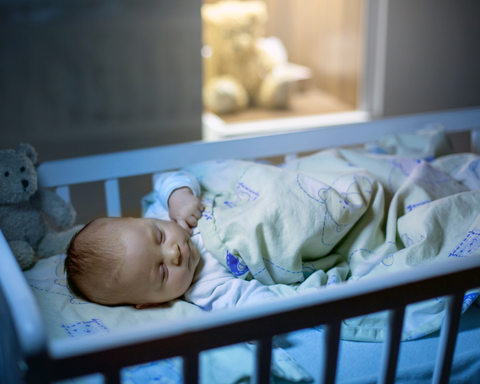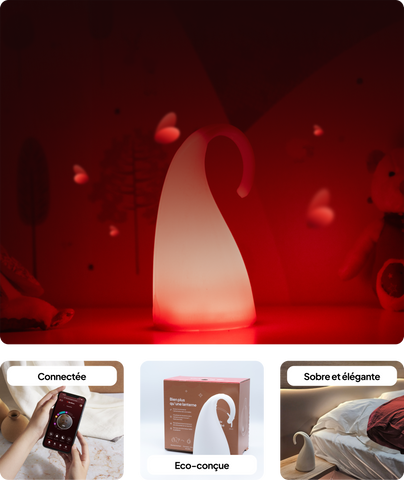A baby's sleep can sometimes be a challenge for parents. Between waking up at night, crying or irregular schedules, nights are sometimes difficult. You probably don't know it, but light plays an essential role in the quality of baby's sleep (and that of adults too). That's why understanding the impact light can have on your body can change the way you prepare your baby for sleep.
The role of light in your baby's sleep cycle
Circadian rhythms, a biological “clock” influenced by light
Circadian rhythms are biological cycles that extend over approximately 24 hours and regulate many essential biological processes. For example activities such as mood, cognitive abilities, or the sleep/wake balance, are all biological rhythms.
These internal rhythms, which are also called the "biological clock", are constantly adjusted according to external signals. The most important of these external factors is the day/night cycle, which plays a vital role in maintaining our biological cycles aligned with the real world. In other words, without these external signals, biological rhythms would be out of sync, making it difficult for you to lead a normal social life or adapt to your environment. Indeed, when the sleep/wake cycle is not synchronized with normal changes in lightness and darkness, this can lead to circadian rhythm disorders such as insomnia, poor sleep quality and fatigue.
Special features of your baby’s sleep cycle
Light has little impact on how babies sleep when they are born, as they have not yet developed the nerve circuit to react to light changes. In fact, it takes between 4 to 8 weeks for the baby's biological clock to settle and for light to have an impact on him. When they are born, babies have a sleep cycle which is regulated by their physiological needs (comfort, nutrition) and not by external light factors. This is why their sleep is irregular during the first several weeks. To help the baby's biological clock synchronize correctly with external light signals, it is recommended that from 8 weeks of age on, to establish darkness during naps and total darkness at night. It is essential that the bedroom is completely dark during the night, as even dim light can pass through the eyelids and send a signal to the brain that it is time to wake up. And that’s certainly not the message we want to send at 2 a.m.!
The effects of light on your baby's sleep
White light is made up of many wavelengths, with each individual wavelength corresponding to the perception of a specific color. When seen altogether, this combination of many different wavelengths gives the impression (perception) of white.
The impact of light on the body
Daylight
In the morning it is advisable to expose yourself to natural daylight. Sunlight contains a large amount of blue light, especially in the morning, which tells your body that it is time to start the day by blocking the production of melatonin. Being exposed to daylight during the day helps regulate the circadian rhythm by making it “understand” that you need to be awake and active.
Blue light: enemy of sleep
In the evening and at night, the more light there is around you, the worse it is for sleep. Excessive exposure to artificial light is likely to upset your ability to fall asleep and to hinder deep sleep. Most artificial lights contain blue wavelengths which send an inappropriate signal to your brain, jolting it into “daytime mode” by blocking the production of melatonin (the hormone that regulates sleep) rather than setting it in “nighttime mode”. In other words, it’s like you’re telling your brain, “Wake up, it’s daytime!” » Which is clearly not what you want at night. Moreover, children are affected even more than adults by blue light, since the lens inside our eyes, through which light must pass, is more transparent in children than in adults and hence allows more light to enter.
Being aware that most lights emit blue light is of paramount importance. It is crucial to understand that it is not the perceived color of the light that poses a problem, but its actual spectral content (i.e. the light from the night light can appear green but it actually also emits some blue light). This is why it is vital to learn about the different lights that you should use during the daytime and evening, or in different rooms in your houses. It is essential to remember that if a child is exposed to too much blue light before going to bed, the sleep-promoting hormone melatonin, which normally starts to be produced when the sun goes down, will be blocked and your child will have a hard time falling asleep.
Red light: an ally for the night
Unlike blue light, red light does not disrupt melatonin production. This is the only light that you can use peacefully at night without disrupting your circadian rhythm. Why does red light not affect your melatonin levels? Red light has a longer wavelength than blue light, and does not stimulate the special cells of the eye which are highly sensitive to blue light. Thus, red light does not interfere with melatonin production.Red light should therefore be the ideal companion of parents who get up several times during the night to look after their baby. Not only is this beneficial for parents, but it is obviously also beneficial for the child. You should also be careful to choose a suitable red light, since classic red LEDs may also emit blue light or other colors different from red (even if you cannot see these colors). Or even if they only contain red spectra, such illumination can be difficult to see easily with (“visual comfort”). The Byeblues baby lantern has been specially designed for visually useful nighttime use, gleaned from more than 30 years of research.
Tips for getting your baby to sleep better
Create an environment conducive to sleep
To get your baby to sleep you can start by creating an environment conducive to sleep. Here are several elements that will help you create a good environment for your child:
- Ventilate the room for at least 30 minutes a day, which will renew the air and regulate humidity.
- Put the baby in a quiet room without noise to avoid additional nighttime awakenings and so that he/she can sleep peacefully.
- Turn off all the lights and close the shutters tightly to preserve melatonin and reduce visual distractions. If you need light when waking up at night, use the Byeblues lantern.
Creating the perfect sleep environment helps baby sleep better and can really make your life easier for them to get through the night!
Establish a bedtime ritual
The ritual will allow your baby to anticipate the night, to understand that he will soon have to sleep. It is also a way of reassuring your baby by offering him a familiar and soothing environment.
To implement this ritual, start little by little, with simple steps repeated every evening. This can happen through a succession of simple actions: bathing, pyjamas, a hug, a little story, then closing the shutters to plunge the room into complete darkness. By repeating this ritual every evening, your baby will associate these moments with bedtime and will slowly understand that it is time to fall asleep. This routine creates a reassuring environment for the baby and facilitates the transition between the hustle and bustle of the day and the calm of the night. Not only does this help him fall asleep more easily, but it also helps establish good long-term sleep habits.
Conclusion
It’s impressive the impact that light can have on your body, don’t you think? Now that you are better informed about the effects of light, and above all how to expose yourself (or not) to it at each time of the day, you have all the right advice to create an environment conducive to sleep for your baby. By applying all these tips, your baby will be able to benefit from a more peaceful sleep, and you will also be able to enjoy calmer and less troubled nights.




